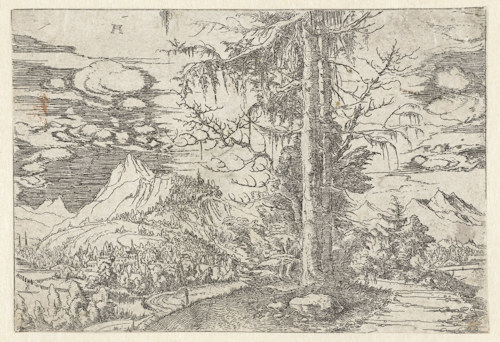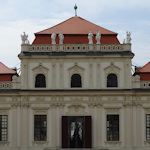Few names survive the cold test of time, but Dürer is one of them. The Age of Dürer at Belvedere casts a rare look at the Austrian art of his era, when the late Gothic began to make way for the delights of the Renaissance.
- Features such artists as Dürer, Lucas Cranach the Elder, Albrecht Altdorfer and Jacopo de’Barbari
- Includes paintings, sculptures, drawings, prints and more
- Runs Oct 21, 2021 – Jan 30, 2022
- See also:
- Belvedere ticket and visitor tips
- Selected past Belvedere exhibitions
- Current art exhibitions in Vienna
Austria at the gate of the Renaissance

(An example of Albrecht Altdorfer’s landscapes. An etching from around 1506 – 1522; image courtesy of the Rijksmuseum)
Periods of transition seem to give rise to creativity. Vienna Modernism, for example, flourished in a city of contrasts clawing its way into an industrialised world, and the movement gave birth to some of the greats of Austrian art history: Klimt, Schiele and associates.
But Austrian art obviously didn’t begin around 1900 and another time of change a few centuries earlier also yielded a rich artistic harvest. The late 1400s and early 1500s saw the Italian Renaissance send increasingly influential tendrils into the Gothic soils of neighbouring countries.
Belvedere’s The Age of Dürer exhibition shines a rare light on this period and showcases, for example, the output of Austrian workshops of the time, when art started to expand beyond its traditional role as a vehicle for religious teaching and moral instruction.
Art began to become a goal in itself, with growing attention to its aesthetic quality.
This development encouraged new approaches and greater sophistication. It increased the range of subjects (literal and figurative) worthy of attention, and artists themselves took on a more “artistic” understanding of their work and purpose.
The era produced its fair share of recognisable masters. Albrecht Dürer, who gives his name to the exhibition title, stands tall among them; his portrait of a young hare graces a million fridge magnets.
Though not from what we call Austria today, Dürer did enjoy the patronage of the Habsburg emperor, Maximilian I.
Other masters of their trade with a connection to the lands of today’s Austria or Habsburg rulers include the likes of Lucas Cranach the Elder, Albrecht Altdorfer and Jacopo de’Barbari.
Works by all the names mentioned above appear in the exhibition, alongside art by lesser-known “Austrian” practitioners who nevertheless deserve recognition for the quality of their output.
The exhibition draws on Belvedere’s own extensive collection of medieval and Renaissance art, supplemented by loans from other prestigious institutions.
Dates and tickets
Enjoy exploring The Age of Dürer from October 21st, 2021 to January 30th, 2022. A standard entrance ticket for Upper Belvedere gets you into the palace and any other exhibitions inside.
How to get to the exhibition
The Age of Dürer takes place in Upper Belvedere palace. Just follow the directions for Belvedere to reach it.
If you enjoy art that’s a few centuries away from being considered contemporary, then the palace stables at Lower Belvedere (which are stables in the same sense that the palace is a house) hosts Belvedere’s medieval collection; particular masterpieces from that era also live on the ground floor of Upper Belvedere palace.
Address: Prinz Eugen-Straße 27, 1030 Vienna
